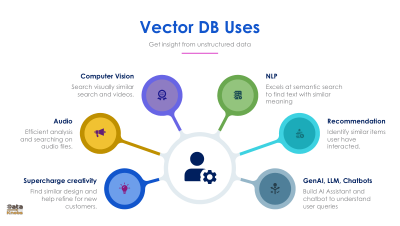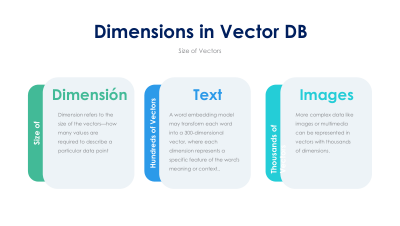Vector Databases for AI & ML | Slides
|
||||||
|
Here we discuss the concept of vectors, their dimensions, significance in various fields, and data transformation operations, highlighting their crucial role in representing and manipulating data efficiently across disciplines like data science and machine learning.
|
||||||
|
|
||||||
|
Vector databases are designed for handling vector data and are optimized for data parallelism, making them ideal for large datasets that require high-performance computing. They are commonly used in fields such as data analytics, machine learning, and scientific computing. On the other hand, NoSQL databases are non-relational databases that can handle large volumes of unstructured data and are known for their scalability and flexible schemas. They are best suited for situations where data doesn't fit neatly into a table or when the data structure may change over time. NoSQL databases are often used in big data and real-time web applications.
|
||||||
|
|
||||||
|
Vector databases and NoSQL both handle unstructred data. Vector DB store embeddings and used in machine learning e.g. AI Assistants, recommendations, search etc.. NoSQL store real data and used for querying e.g. Big data scenarios nd also used in real time web applications.
|
||||||
|
|
||||||
|
In this slide we discuss the efficient storage and management of vector data using specialized vector databases, highlighting their role in similarity search tasks through algorithms like nearest neighbor search and various indexing techniques.
|
||||||
|
|
||||||
|
Vector databases store data in a vector format, enabling efficient storage and retrieval based on similarity metrics. In retrieval augmented generation, these databases enhance search and recommendation systems by quickly retrieving similar items using vector representations, facilitating personalized recommendations and efficient search functionalities.
|
||||||
|
|
||||||
|
Learn about the essential CRUD operations (Create, Read, Update, Delete) on vector data, which is crucial for effectively managing and manipulating spatial information. The guide covers creating new data, reading attributes and geometry, updating existing features, and deleting outdated or erroneous data from the database.
|
||||||
|
|
||||||
|
Here are real-world applications of geospatial technology across various industries, including logistics, retail, urban planning, healthcare, and agriculture. It highlights how location-based services are utilized for route optimization, marketing strategies, city infrastructure management, disease tracking, and precision farming to enhance efficiency and decision-making processes.
|
||||||
|
|
||||||
|
The cost of a vector database is influenced by factors such as the number of indices, dimensions of the data, inference/access frequency, storage space, and processing power required.
|
||||||
|
|
||||||
|
Here is a list of interview questions for evaluating candidates' knowledge and understanding of vector databases, including their definition, usage, advantages and disadvantages, indexing, and data security measures.
|
||||||
|
|
||||||
2-how-vector-databases-work-i Challenges-frequent-update Criteria-to-select-vector-db Crud Operations For Vector DB Tutorials Uses-of-vector-db Vector-db-anti-patterns Vector-db-applications Vector-db-crud Vector-db-dimensions












